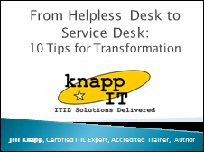It’s finally happened: Foundation exams for ITIL Version 2 are officially retired and no longer available to new students. And when there’s no certification to earn, training is no longer perceived as valuable by the average Joe. This makes me sad since I cut my ITSM teeth on ITIL V2; so it will always hold a dear place in my heart.
But sentimentality aside, I think ITIL V2 still offers some value, especially for smaller organizations or companies just starting on the ITSM path.1
ITIL Version 2 was published in 1999-2000 and is a set of nine2 books, but the exam syllabus only covered the two most popular volumes from the set: Service Support and Service Delivery. With only two books to master, ITIL was a much simpler beast back then, with its ten processes and single function (compare that to V3’s 24-ish processes and four functions). True, the world and its technology have changed radically since Y2K, but ITIL isn’t about technology. It’s mostly about processes; and V2’s meat-and-potatoes processes (Incident, Problem, Change, Release, Config, SLM) haven’t really changed all that much from V2 to V3.
Many organizations have opted to stick with ITIL V2, despite the sunset. ITIL’s just a framework, after all; and once you adapt it to make it your own, the underlying framework becomes less relevant. The problem arises as these organizations hire new employees; getting them trained and certified in the same version as everyone else can be challenging, as fewer training companies continue to offer V2 training.
If certification isn’t the most important thing, you should ask your training provider if they’ll teach V2 classes without the certification. I can’t imagine any training company would turn away the work (and if they do, call me directly and I’ll be glad to teach it!).
If certifications are important however, then you’ll need to dive into ITIL Version 3. But how?
Consider retraining some of your managers / supervisors / leaders in ITIL V3. Once they get the hang of it, you can then decide if training everyone in V3 is the way to go, or if taking a hybrid approach (V2 for the operational worker bees; V3 for managers and above) makes more sense.
Stay tuned, and I’ll address the pros and cons of a V2/V3 hybrid approach in a later post.
——————
1 There are books designed to assist the smaller organizations get their ITIL V3 implementation off the ground: ITIL Lite: A Road Map to Full or Partial ITIL Implementation, as well as an official OGC publication called “ITIL V3 Small Scale Implementation. However, there never were any certifications or formal OGC-approved training classes around these books, which means that if you find someone offering a class on such a thing, the instructor wouldn’t be adhering to a set OGC-blessed syllabus. (This, of course, may be a good thing depending on your perspective… heh.)
2 ITIL V2 was originally published as eight books, not nine. But the 9th book (ITIL Small Scale Implementation) was published in 2006, prior to the release of ITIL V3. This book is different than the Small Scale Implementation book mentioned in the previous footnote.3
3 Are you really reading all of these footnotes? <vader voice> Impressive! </vader voice>


Very cute; I chuckled. Poor ITIL v2!
As you know, our company is one of those that takes the hybrid approach, and it works very well for us.
What do you think of the V3 ITIL lite?
Hi Jake,
Thanks for your comment!
I’m a fan of the ITIL Lite book. It was written by Malcolm Fry, who is absolutely wonderful. Click the little YouTube video on that page, and you’ll get a taste of what ITIL Lite is, as well as Malcolm’s awesomeness.
The great folks at Service Sphere have posted an excerpt of a symposium Mr. Fry gave on ITIL Lite; you can check it out by going here: http://www.servicesphere.com/blog/2010/4/18/less-filling-more-taste-itil-lite-the-workshop-review.html
[…] This post was mentioned on Twitter by Jill Knapp (ITIL) and mrlich. mrlich said: Check out this touching video! RT @Knapp_IT: My tribute to #ITIL #V2. http://bit.ly/drL0qB Farewell, old friend. #ITSM […]